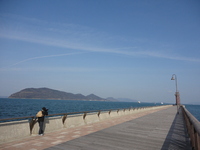2011年01月26日
New Year’s Traditions
Japanese New Year’s and Christmas are very different holidays. Yet some things about the two seem surprisingly similar.
Christmas as celebrated by my Canadian family is a time for reconnecting with family and friends through Christmas cards. In Japan, we do the same but with New Year’s cards. Here is the bundle we received on New Year’s Day.

Many are just store bought but some are personally designed and even handmade like the selection below. As you can see by the pictures, 2011 is the year of the rabbit.

Christmas in Canada as I remember it, is a time spent celebrating the joy of being together, free from the busyness of everyday life. Japanese New Year’s is the same. Everyone heads “home” to be with family and the mass of humanity leaving the big cities clogs up the transportation system for several days. We were happy to have our two city dwelling kids join us from Tokyo.

Christmas and New Year’s are both religious festivals. In Japan, the New Year is welcomed in by tolling the temple bell at midnight on December 31. The bell is tolled once for each of 108 worldly passions to wipe the slate clean for the coming year. This is followed over the next few days by a trip to a shrine (or 2 or 3) to pray for good fortune. The lineup of people at Tamura Shrine went all the way out the gate and down the street. Obviously, this is still a popular custom.

Lining up to pray (photo from Jan. 2010)

Finally, both Christmas and Japanese New Year’s mean food and hospitality and the traditional foods, while very different, are prepared with the same concept in mind – to feed a large number of people for some time and free the cook from the kitchen. I remember preparing sweets weeks before Christmas and storing them in the pantry to serve visitors during the Christmas season. While the turkey was made on Christmas Day, it also seemed to last for at least a week, reappearing as soup or sandwiches.
Japanese traditional New Year’s foods likewise are made ahead and made to last. One of these is mochi, glutinous rice cooked, pummeled and molded into cakes. A friend kindly invited us to join their family’s annual mochi-making gathering. The process is labor intensive and therefore everyone took turns pounding and shaping. Here is the rice being steamed,

pounded in a stone mortar
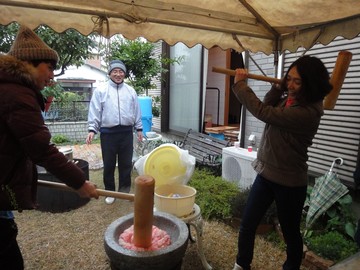
and hand shaped by a pro.

The result is a colorful array of mochi in black bean, dried shrimp, seaweed and plain flavors that last at least a month when they have dried.

Much of the pounded rice, however, was consumed while still hot before it even had the chance to become mochi. Various fillings and sauces included bean paste, grated daikon and soy sauce, soy sauce and sugar, strawberries and chocolate almonds. Mmmmm!! Delicious.
This is what mochi looked like on New Year’s Day in the traditional New Year’s soup called zoni.
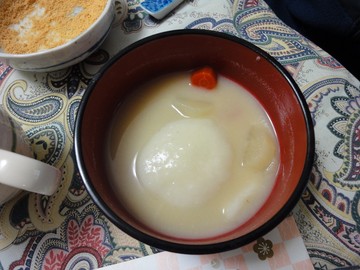
The contents of zoni and the way the mochi are eaten differ from one area to another. In Takamatsu, zoni is made with sweet, white miso and the mochi are filled with bean paste. This custom appears to be unique to the Kagawa region and often grosses out people from other areas who haven’t tried it. It’s actually quite tasty.
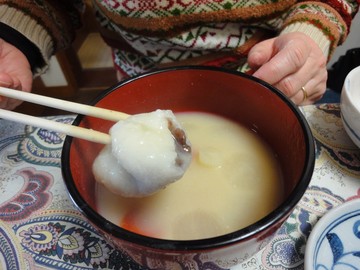
My mother-in-law, however, is from Osaka, near Nara, so our family’s tradition has been passed down from her. The soup is still white miso, but the mochi are allowed to dissolve into a gluey mess, then removed from the soup and coated with soybean flour and sugar. It tastes far better than it looks!
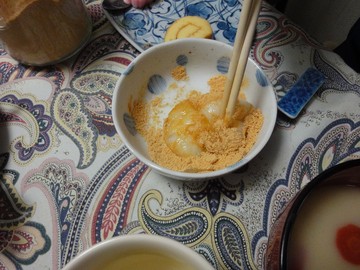
I hope you all enjoyed your own special family traditions this holiday. Best wishes for 2011.
Christmas as celebrated by my Canadian family is a time for reconnecting with family and friends through Christmas cards. In Japan, we do the same but with New Year’s cards. Here is the bundle we received on New Year’s Day.
Many are just store bought but some are personally designed and even handmade like the selection below. As you can see by the pictures, 2011 is the year of the rabbit.
Christmas in Canada as I remember it, is a time spent celebrating the joy of being together, free from the busyness of everyday life. Japanese New Year’s is the same. Everyone heads “home” to be with family and the mass of humanity leaving the big cities clogs up the transportation system for several days. We were happy to have our two city dwelling kids join us from Tokyo.
Christmas and New Year’s are both religious festivals. In Japan, the New Year is welcomed in by tolling the temple bell at midnight on December 31. The bell is tolled once for each of 108 worldly passions to wipe the slate clean for the coming year. This is followed over the next few days by a trip to a shrine (or 2 or 3) to pray for good fortune. The lineup of people at Tamura Shrine went all the way out the gate and down the street. Obviously, this is still a popular custom.

Lining up to pray (photo from Jan. 2010)

Finally, both Christmas and Japanese New Year’s mean food and hospitality and the traditional foods, while very different, are prepared with the same concept in mind – to feed a large number of people for some time and free the cook from the kitchen. I remember preparing sweets weeks before Christmas and storing them in the pantry to serve visitors during the Christmas season. While the turkey was made on Christmas Day, it also seemed to last for at least a week, reappearing as soup or sandwiches.
Japanese traditional New Year’s foods likewise are made ahead and made to last. One of these is mochi, glutinous rice cooked, pummeled and molded into cakes. A friend kindly invited us to join their family’s annual mochi-making gathering. The process is labor intensive and therefore everyone took turns pounding and shaping. Here is the rice being steamed,
pounded in a stone mortar
and hand shaped by a pro.
The result is a colorful array of mochi in black bean, dried shrimp, seaweed and plain flavors that last at least a month when they have dried.
Much of the pounded rice, however, was consumed while still hot before it even had the chance to become mochi. Various fillings and sauces included bean paste, grated daikon and soy sauce, soy sauce and sugar, strawberries and chocolate almonds. Mmmmm!! Delicious.
This is what mochi looked like on New Year’s Day in the traditional New Year’s soup called zoni.
The contents of zoni and the way the mochi are eaten differ from one area to another. In Takamatsu, zoni is made with sweet, white miso and the mochi are filled with bean paste. This custom appears to be unique to the Kagawa region and often grosses out people from other areas who haven’t tried it. It’s actually quite tasty.
My mother-in-law, however, is from Osaka, near Nara, so our family’s tradition has been passed down from her. The soup is still white miso, but the mochi are allowed to dissolve into a gluey mess, then removed from the soup and coated with soybean flour and sugar. It tastes far better than it looks!
I hope you all enjoyed your own special family traditions this holiday. Best wishes for 2011.
My Profile
Cathy Hirano キャシー ヒラノ
I've lived in Japan since 1978. After graduating from a Japanese university with a BA in cultural anthropology in 1983, I worked as a translator in a Japanese consulting engineering firm in Tokyo for several years. My Japanese husband and I moved to Takamatsu in 1987 to raise our two children in a slower-paced environment away from the big city pressures. We've never regretted it. I work as a freelance translator and interpreter and am involved in a lot of community work, including volunteering for Second Hand, a local NGO that supports educational and vocational training initiatives in Cambodia, and for the Takamatsu International Association. I love living in Takamatsu.
Cathy Hirano キャシー ヒラノ
I've lived in Japan since 1978. After graduating from a Japanese university with a BA in cultural anthropology in 1983, I worked as a translator in a Japanese consulting engineering firm in Tokyo for several years. My Japanese husband and I moved to Takamatsu in 1987 to raise our two children in a slower-paced environment away from the big city pressures. We've never regretted it. I work as a freelance translator and interpreter and am involved in a lot of community work, including volunteering for Second Hand, a local NGO that supports educational and vocational training initiatives in Cambodia, and for the Takamatsu International Association. I love living in Takamatsu.
Posted by cathy at 09:00│Comments(1)
│art
この記事へのコメント
I think the thing I prefer from Japan is this:
"<insert whatever holiday or event> means food and hospitality"
:-)
I had Zoni last year (homemade in France!). Quite tasty indeed.
"<insert whatever holiday or event> means food and hospitality"
:-)
I had Zoni last year (homemade in France!). Quite tasty indeed.
Posted by David at 2011年02月02日 21:40
※会員のみコメントを受け付けております、ログインが必要です。

